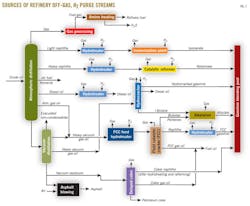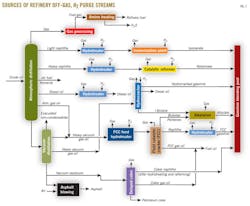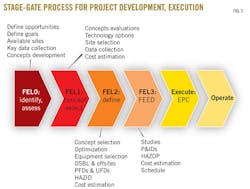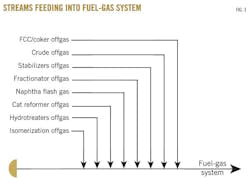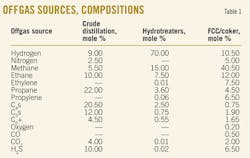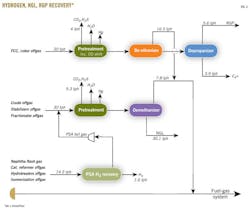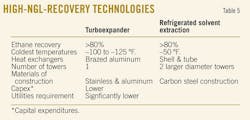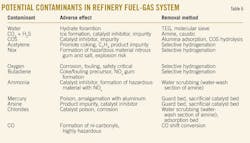Market conditions encourage refiners to recover by-product gases
Guang Lee
Jie Yu
Sudhir V. Golikeri
Benjamin Klein
Bechtel Hydrocarbon Technology Solutions Inc.
Houston
| Based on a presentation to 2013 AIChE Spring Meeting and 9th Global Congress on Process Safety, Apr. 28-May 2, 2013, San Antonio. |
Segregating fuel-gas blending streams and extracting hydrogen, NGLs, ethylene, and propylene provide a moderate capital cost route for a refinery to improve profitability. This strategy is today triggered by the "perfect storm" conditions of low natural gas cost (to replace the heating value of extracted gases) and higher values for recovered components.
Refineries have long dealt with constantly changing market conditions. Currently, reduced domestic gasoline consumption, required ethanol blending, improved vehicle miles per gallon, and more stringent fuel-quality specifications have exacerbated the situation. Capturing opportunities to improve margins will be crucial for survival and sustained profitability.
Over decades of operation, refinery fuel-gas systems have become the repository for purge gases from fluidized catalytic cracking, delayed coking, catalytic reforming, hydrotreating, hydrocracking, and other process units. Fig. 1 illustrates the various sources of hydrocarbon offgas and hydrogen purge streams in a typical refinery. Flare-gas recovery systems also contribute to the build-up of non-methane components in refinery fuel gas. Hydrogen concentrations of 50 vol % (and higher) are not unusual.
Hydrogen recovery and purification avoid costs of on site hydrogen manufacture or import from area pipelines. Capital costs vary widely, depending on refinery size and complexity and the scope of targeted component recoveries.
While there is no "typical" recovery project, a case study has shown such projects have attractive economics with payback of 1-3 years. Capital costs ranged from less than $5 million to about $100 million.
Technology strategies for extraction and purification include cryogenic, pressure-swing adsorption (PSA), semi-permeable membranes, compression, and gas treating.
Background
While most refineries have added conversion and treating units and experience capacity creep over several decades, fuel-gas systems have generally received little attention. Refinery fuel gas contains large concentrations of hydrogen, ethylene, propylene, ethane, propane, and heavier paraffinic components. Today's fuel-gas composition differs sharply from original designs based on natural gas.
The current outlook for refinery gas processing in the US is discouraging for several reasons. Production from newly discovered abundant reserves of shale gas has sharply driven down natural gas prices to $2-3.50/MMbtu. Industry experts project the price to remain around $4/MMbtu over the next decade.1 At these prices, recovering NGLs as feedstocks for petrochemicals and other uses is becoming attractive.
Because refinery fuel gas is valued the same as natural gas, NGLs and olefins in the fuel gas are becoming increasingly more valuable. Naphtha derived from crude oil as well as NGLs are the alternative routes for producing ethylene, propylene and other basic chemicals.
Since commodity chemical prices are set globally by naphtha-based producers, cheaper natural gas is thus giving US chemical companies an edge over global rivals. That enables US companies to earn higher margins from using less expensive natural gas.
This dynamic justifies investments in gas processing projects for liquids recovery. Also, hydrogen recovery incentives derive from increasing demand to produce cleaner transportation fuels to process heavy and sour crudes from increased hydroprocessing capacity and also the need to abate refinery CO2 emissions.
Refinery gas processing
Assessing the attractiveness of the liquids and hydrogen recovery project requires a thorough understanding of the current operation and focus on the following considerations:
- What process, equipment, and piping changes are needed to segregate and reconfigure individual blending streams?
- Can the hydrogen recovery significantly reduce purchases or internal production by steam-methane reforming?
- Will higher purity hydrogen debottleneck hydrotreaters and reduce purge-gas rates?
- Will this be a brownfield or greenfield installation?
- Is there a local market or existing product pipeline for liquid products?
- What are the capital and operating costs?
- What are the product prices?
- Are the utilities and support services available?
A refinery by-product recovery project will follow the standard stage-gate process (Fig. 2).
Assessing if a particular refinery is a candidate for potential hydrogen and liquids recovery requires identifying opportunities then developing various technical concepts:
- Tabulation of all streams (vents, purges) entering the fuel-gas system with their compositions, including trace contaminants, average and peak flow rates, operating pressure, and temperature at its source.
- Existing fuel-gas distribution flow schematic.
- Hydrogen system flow schematic and stream composition data: hydrogen generation and purification, compression, make-up H2 streams to individual hydroprocessing units, hydrogen purges from individual hydroprocessing units, catalytic reforming unit net hydrogen production, other hydrogen recovery and purification (pressure-swing adsorption, membrane).
- Existing NGL recovery (if any): flow schematic and stream composition data.
- Existing propylene or ethylene recovery (if any): flow schematic and stream composition data.
In Front-end Loading Phase 1 (FEL-1; Fig. 2), each concept is simulated for evaluation. A systematic evaluation of all competing technologies for each recovery section is vital eventually to arrive at the best combined process scheme. Site visit with piping and layout, construction and cost-estimating professionals is essential to determine suitable location as well as to improve constructability, maintainability, and the accuracy of cost estimate.
Cost-estimating can involve multiple project execution strategies, such as a single project for all recovery sections for best cost efficiency or phased implementation to spread the investment due to funding or construction intensity constraints.
During FEL-2, it is customary to develop in more detail and optimize the best concept by developing process flow diagrams, utility flow diagrams, equipment data sheets, and so forth. In this phase, more accurate cost estimate is performed based on vendor quotes for major equipment, site preparation, project schedule, and any utilities, outside battery limits, and support services requirement. Risk assessment review (hazard identification study) should be performed in this phase.
Case study
Fig. 3 shows a scenario in which multiple offgas streams with high concentrations of hydrogen, olefin, and NGLs are fed to the fuel-gas system. The first step to evaluate a liquids-hydrogen recovery project would be to collect stream data, understand the current operation and configuration, and establish recovery goals for hydrogen, NGL, and refinery-grade propylene (RGP). Product and feed pricing information will be necessary to determine the project economics.
Table 1 lists several refinery offgas streams and their typical compositions. Large quantities of valuable components such as ethane, propane, ethylene, propylene, and hydrogen are present in these streams. The goals are to:
- Increase hydrogen recovery to reduce steam-methane reformer firing.
- Recover ethane-plus components as NGL product.
- Recover RGP as product.
The next step is to evaluate alternatives to segregate and process these streams to meet the above goals. Fig. 4 shows a potential process configuration and its overall material balance.
The fluid catalytic cracker and coker offgas stream, containing unsaturated hydrocarbons, is segregated from the saturated hydrocarbons. After pretreatment to remove CO, CO2/H2S, mercury, and moisture, the dried stream is sent to a de-ethanizer to recover C3+ component, while the residue gas is sent to the fuel-gas system. The pretreatment unit may also contain feed compression.
The recovered liquid stream is further fractionated in a depropanizer to achieve 95% recovery of RGP from the overhead. The remaining C4+ stream is sent to existing fractionation.
Streams with high hydrogen content, such as the catalytic reformer offgas and hydrotreater's offgas, are segregated from other lower hydrogen content streams. The combined high hydrogen stream is routed to a PSA unit to recover at least 80% of the hydrogen at 99.9 mole % purity. The hydrogen-lean tail gas is compressed and combined with other lower hydrogen content streams.
The combined stream undergoes pretreatment to remove CO2/H2S, mercury, and moisture. The pretreatment unit may also contain feed compression. The dried stream is sent to a demethanizer to recover about 80% of the C2+ component as NGL product. The residue gas is sent to the fuel-gas system.
Project considerations
Tables 2 and 3 summarize simple economic evaluation.
Table 2 contains results for the NGL and hydrogen recovery; Table 3 provides the results for RGP recovery. The evaluations are based on the use of PSA for hydrogen recovery and cryogenic turboexpander technology with supplemental propane refrigeration for NGL and RGP recovery.
For the NGL and hydrogen-recovery project, the payback is 1-2 years, based only on NGL recovery. In case the refinery currently purchases hydrogen, the economics will be even better because the additional hydrogen recovery reduces these purchases.
For the RGP recovery project, the payback time is estimated to be less than 3 years. The economics for both projects can significantly improve with sufficient availability of utilities and by sharing a common refrigeration system.
With simultaneous execution of NGL, RGP, and hydrogen-recovery projects, the payback time of less than 2 years is possible.
Hydrogen-recovery options
Commercially proven hydrogen-recovery technologies include PSA, membranes, and cryogenic systems. Each technology has its own merits and constraints; Table 4 provides a comparison among those technologies.2
Adsorption (PSA system) is the best choice when ultrahigh purity, 99.9%+, hydrogen product is required. This is a cyclical process based on pressure-swing adsorption that employs multiple beds in parallel. The impurities in the hydrogen-rich feed as in a refinery offgas (ROG) are adsorbed at moderate pressure and subsequently desorbed at low pressure. PSA produces hydrogen at essentially feed pressure.
Hydrogen recoveries (typically about 80%) depend on feed conditions, hydrogen product specifications, and system configuration. The tail gas consisting of impurities in the PSA feed and unrecovered H2 is delivered at low pressure and is available for fuel. Since the tail gas is rich in NGL, it can be compressed and sent for NGL recovery.
The ability of a PSA system to produce hydrogen at high purity can benefit the refiner through longer catalyst life and reduction of inerts introduced into the hydroprocessing unit.
Membranes could provide a low-cost solution for high-pressure ROG feeds, especially when integration with existing hydrogen compression is possible. Membrane systems are bulk separators that produce refinery-quality hydrogen purities of 90-98% at high recoveries (85% or better). Because pressure drives the separation, they are best suited for high-pressure feeds (>20 barg or 300 psig) such as hydroprocessing purge gases.
A common disadvantage of membranes is that the hydrogen product stream is produced at pressures much lower than the feed pressure and may need recompression. The hydrogen product may be sent to existing make-up or recycle compression in hydroprocessing loops. An important consideration for ROG applications is that H2S is also a "fast gas" through the membrane polymer and will end up in the hydrogen product.
Concerns of fouling, plasticization, and condensation of hydrocarbon vapors on the membrane surface, however, need to be properly addressed when considering application of membranes in refineries.
Cryogenics is another route to recover 95 mole % hydrogen from ROG feeds when by-product liquid hydrocarbons can subsidize the higher capital expenditure. Temperatures in the range of -250° F. are required. Proper pretreatment is necessary to avoid freezing of moisture, CO2, and aromatic components such as benzene, toluene, ethylbenzne, and xylenes (BTEX).
Other contaminants in the feed, such as mercury and NOx, must be monitored and removed to avoid corrosion and ensure safe operation of the commonly employed brazed aluminum exchangers. Without liquids recovery to offset the higher capital costs, cryogenic hydrogen separation systems cannot generally be justified over the other separation technologies.
NGL, olefins recovery
Among the commercially proven technologies for NGL recovery are Joule-Thomson expansion, conventional mechanical refrigeration, cryogenic turboexpander, lean-oil absorption, and membranes.
J-T expansion process uses the Joule-Thomson effect to reduce the gas temperature upon expansion from a pressure-reducing (J-T) valve. With appropriate heat exchange and sufficient pressure differential across the J-T valve, sufficient temperature reduction can be achieved to recover NGL.
The J-T expansion process offers advantages such as simplicity in design and operation, but it is only suitable for dewpoint control or when low NGL recovery is needed.
Conventional refrigeration generally maintains the gas pressure through the process. The gas is heat exchanged and then cooled by the refrigeration chiller to a specified temperature. Liquid is separated from a cold separator. The straight refrigeration process is most suitable for dewpoint control or for modest (<50%) ethane recovery.
The cryogenic turboexpander process has been predominantly used for high ethane recovery. The process expands the feed gas through a turboexpander to produce needed refrigeration. Energy recovered from this gas expansion is typically used to drive a linked compressor to compress the residue gas or the feed gas.
External refrigeration may be needed when processing feeds rich in NGL components or when high ethane recovery is targeted. The focus of this design is to provide sufficient reflux to the demethanizer to attain low overhead temperature and high ethane recovery.
Because of the cryogenic temperatures, proper metallurgy (stainless steel and aluminum) is needed. Typically brazed aluminum exchangers are employed that result in compact layout. Care must be taken to provide proper pretreatment to remove potential contaminants in the feed that are prone to freeze at cryogenic temperatures.
A properly designed cryogenic turboexpander process can provide highly reliable and efficient performance.
In lean oil (solvent) absorption, the NGLs are extracted by contacting the ROG with a liquid hydrocarbon solvent (lean oil) in an absorber column. The rich oil with absorbed NGLs is then distilled to recover the NGLs and return the regenerated lean oil to the absorber column. A refrigerated system enhances the recovery of lighter hydrocarbon components such as ethane and propane.
The lean oil is usually a mixture of paraffinic compounds, frequently extracted from the feed, with a molecular weight between 100 and 200.
Lean-oil absorption processes have the advantage that the absorber can operate at essentially feed-gas pressure with minimal loss of pressure for the exiting gas stream. Further, lean-oil plants, whether ambient or refrigerated, are constructed of carbon steel. An additional benefit of the refrigerated lean-oil process is that it is less susceptible to such contaminants in feed gas as CO2, H2S, moisture, mercury, and arsenic.
The lean-oil process usually requires larger processing equipment with higher energy requirements.
Membrane technology can be used for propane or heavier components recovery.3 4 After compression and air cooling, a portion of the water and C3+ hydrocarbons is condensed and recovered. The offgas from the condenser is then passed across a semipermeable membrane that preferentially permeates C3+ hydrocarbons. It should be noted that ethane is not recovered in the permeate.
Table 5 compares the two potential technology options for higher (>80%) ethane and NGL recovery:
A refinery fuel-gas system can contain a host of impurities and trace contaminants (Table 6) that can degrade operation or product purities. The recovery processes need to take these into account carefully and design appropriate removal methods.5 6
Benefits of fired heaters
Fuel-gas quality changes create formidable challenges for burner management in process and utility fired heaters. Recent environmental regulations have led to most fired heaters being retrofitted with low NOx burners that use gas tip orifices that are much smaller than older technology units.
The fired heaters provide best performance with fuel of steady heating value and in composition similar to that used for the burner design. Burner control problems occur when there is sudden change in heating value due to intermittent streams of vastly different composition entering the fuel-gas system.
Fuel with high hydrogen burns with higher flame temperature and produces higher NOx. Fuel with heavy hydrocarbons has a higher dewpoint and is prone to liquid condensation and carryover to the burners resulting in coking and plugging. Other contaminants include pipe scales, catalyst fines, water, and hydrocarbon aerosols.
Of course, these problems can be mitigated by proper pretreatment such as filtration and providing superheat. Fuel-gas recovery projects would eliminate some of the operating problems and could result in improved and more reliable operation.
C2 recovery, rejection flexibility
Among NGLs, ethane prices are the most volatile. Units designed for high ethane recovery operate profitably when ethane prices are high. From time to time, however, when ethane prices drop, there is little incentive for high recovery.
The flexibility to switch between ethane recovery and ethane rejection can be designed into such liquids-recovery plants to adapt to the swings in ethane prices.
References
1. Annual Energy Outlook 2013 (AEO2013) Early Release Overview, US Energy Information Administration.
2. Patel, N., Baade, B., and Khurana, V., "Creating Value through Refinery Hydrogen Management," Asian Refinery Technology Conference, March 2006, Singapore.
3. Baker, R., "Future Directions of Membrane Gas Separation Technology," Ind. Eng. Chem. Res., Vol. 41 (2002), pp. 1393-1411.
4. Alvarado, D., and Gottschlich, D.E., "Membrane Matrimony," Hydrocarbon Engineering, September 2005.
5. Chuang, Sheng Y., Nanda, Rajeev, and Rizopoulos, John, "Refinery Off Gas Treatment and Recovery – Challenges of Designing ROG Units," NPRA Annual Meeting, Mar. 9-11, 2008, San Diego.
6. Malik, Zaheer I., and Slack, John W., "How to Treat Refinery Gases And Make Them Suitable to Recover Valuable Liquids," GPA Annual Convention, Mar. 8-11, 2009, San Antonio.
The authors
Guang Lee ([email protected]) is a process technologist for Bechtel Hydrocarbon Technology Solutions (BHTS) Inc., Houston. He has more than 15 years of experience in cryogenic technologies for gas processing, LNG, and ethylene industries. He holds a PhD in process integration from the University of Manchester and a BSc in chemical engineering from National Taiwan University. Lee is a member of AIChE and the Houston chapter of the Gas Processors Association.
Jie Yu ([email protected]) is a process engineer for BHTS. She has worked on various gas processing and LNG related studies. She holds a PhD in chemical engineering from Rice University, Houston.
Sudhir Golikeri ([email protected]) is manager of gas processing for BHTS. He previously worked for MW Kellogg, Davy McKee, Amoco and BP. He holds a PhD in chemical engineering from the University of Houston.
Benjamin Klein ([email protected]) is refining technology manager for BHTS. He is a senior refining technologist with 41 years of industry experience, the last 14 years with Bechtel. He has previous experience with technology licensors Hydrocarbon Research Inc., ABB Lummus Global, and M.W. Kellogg. He holds a BS from Rensselaer Polytechnic Institute and an MS from Purdue University, both in chemical engineering, and is a senior member of AIChE.
